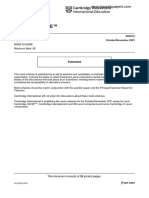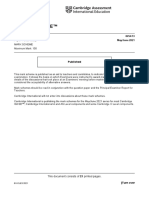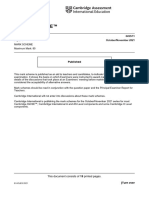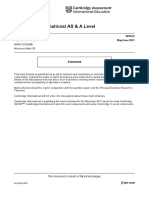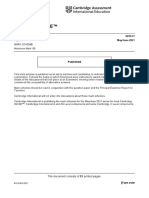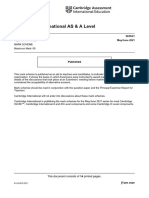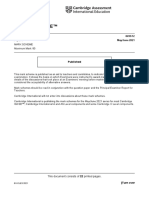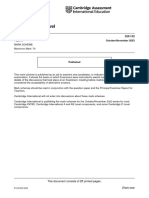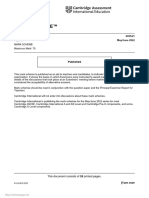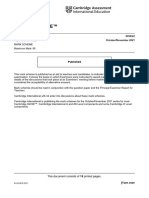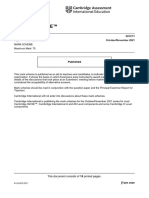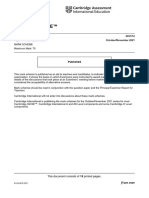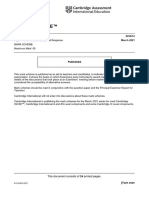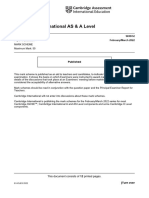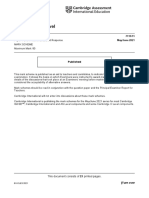Cambridge IGCSE™: Sociology 0495/22 May/June 2021
Cambridge IGCSE™: Sociology 0495/22 May/June 2021
Uploaded by
venshiteemulCopyright:
Available Formats
Cambridge IGCSE™: Sociology 0495/22 May/June 2021
Cambridge IGCSE™: Sociology 0495/22 May/June 2021
Uploaded by
venshiteemulOriginal Title
Copyright
Available Formats
Share this document
Did you find this document useful?
Is this content inappropriate?
Copyright:
Available Formats
Cambridge IGCSE™: Sociology 0495/22 May/June 2021
Cambridge IGCSE™: Sociology 0495/22 May/June 2021
Uploaded by
venshiteemulCopyright:
Available Formats
www.dynamicpapers.
com
Cambridge IGCSE™
SOCIOLOGY 0495/22
Paper 2 May/June 2021
MARK SCHEME
Maximum Mark: 70
Published
This mark scheme is published as an aid to teachers and candidates, to indicate the requirements of the
examination. It shows the basis on which Examiners were instructed to award marks. It does not indicate the
details of the discussions that took place at an Examiners’ meeting before marking began, which would have
considered the acceptability of alternative answers.
Mark schemes should be read in conjunction with the question paper and the Principal Examiner Report for
Teachers.
Cambridge International will not enter into discussions about these mark schemes.
Cambridge International is publishing the mark schemes for the May/June 2021 series for most Cambridge
IGCSE™, Cambridge International A and AS Level components and some Cambridge O Level components.
This document consists of 31 printed pages.
© UCLES 2021 [Turn over
0495/22 www.dynamicpapers.com
Cambridge IGCSE – Mark Scheme May/June 2021
PUBLISHED
Generic Marking Principles
These general marking principles must be applied by all examiners when marking candidate answers.
They should be applied alongside the specific content of the mark scheme or generic level descriptors
for a question. Each question paper and mark scheme will also comply with these marking principles.
GENERIC MARKING PRINCIPLE 1:
Marks must be awarded in line with:
• the specific content of the mark scheme or the generic level descriptors for the question
• the specific skills defined in the mark scheme or in the generic level descriptors for the question
• the standard of response required by a candidate as exemplified by the standardisation scripts.
GENERIC MARKING PRINCIPLE 2:
Marks awarded are always whole marks (not half marks, or other fractions).
GENERIC MARKING PRINCIPLE 3:
Marks must be awarded positively:
• marks are awarded for correct/valid answers, as defined in the mark scheme. However, credit
is given for valid answers which go beyond the scope of the syllabus and mark scheme,
referring to your Team Leader as appropriate
• marks are awarded when candidates clearly demonstrate what they know and can do
• marks are not deducted for errors
• marks are not deducted for omissions
• answers should only be judged on the quality of spelling, punctuation and grammar when these
features are specifically assessed by the question as indicated by the mark scheme. The
meaning, however, should be unambiguous.
GENERIC MARKING PRINCIPLE 4:
Rules must be applied consistently, e.g. in situations where candidates have not followed
instructions or in the application of generic level descriptors.
GENERIC MARKING PRINCIPLE 5:
Marks should be awarded using the full range of marks defined in the mark scheme for the question
(however; the use of the full mark range may be limited according to the quality of the candidate
responses seen).
GENERIC MARKING PRINCIPLE 6:
Marks awarded are based solely on the requirements as defined in the mark scheme. Marks should
not be awarded with grade thresholds or grade descriptors in mind.
© UCLES 2021 Page 2 of 31
0495/22 www.dynamicpapers.com
Cambridge IGCSE – Mark Scheme May/June 2021
PUBLISHED
Social Science-Specific Marking Principles
(for point-based marking)
1 Components using point-based marking:
• Point marking is often used to reward knowledge, understanding and application of skills.
We give credit where the candidate’s answer shows relevant knowledge, understanding
and application of skills in answering the question. We do not give credit where the answer
shows confusion.
From this it follows that we:
a DO credit answers which are worded differently from the mark scheme if they clearly
convey the same meaning (unless the mark scheme requires a specific term)
b DO credit alternative answers/examples which are not written in the mark scheme if they
are correct
c DO credit answers where candidates give more than one correct answer in one
prompt/numbered/scaffolded space where extended writing is required rather than list-type
answers. For example, questions that require n reasons (e.g. State two reasons …).
d DO NOT credit answers simply for using a ‘key term’ unless that is all that is required.
(Check for evidence it is understood and not used wrongly.)
e DO NOT credit answers which are obviously self-contradicting or trying to cover all
possibilities
f DO NOT give further credit for what is effectively repetition of a correct point already
credited unless the language itself is being tested. This applies equally to ‘mirror
statements’ (i.e. polluted/not polluted).
g DO NOT require spellings to be correct, unless this is part of the test. However spellings of
syllabus terms must allow for clear and unambiguous separation from other syllabus terms
with which they may be confused (e.g. Corrasion/Corrosion)
2 Presentation of mark scheme:
• Slashes (/) or the word ‘or’ separate alternative ways of making the same point.
• Semi colons (;) bullet points (•) or figures in brackets (1) separate different points.
• Content in the answer column in brackets is for examiner information/context to clarify the
marking but is not required to earn the mark (except Accounting syllabuses where they
indicate negative numbers).
3 Calculation questions:
• The mark scheme will show the steps in the most likely correct method(s), the mark for
each step, the correct answer(s) and the mark for each answer
• If working/explanation is considered essential for full credit, this will be indicated in the
question paper and in the mark scheme. In all other instances, the correct answer to a
calculation should be given full credit, even if no supporting working is shown.
• Where the candidate uses a valid method which is not covered by the mark scheme,
award equivalent marks for reaching equivalent stages.
• Where an answer makes use of a candidate’s own incorrect figure from previous working,
the ‘own figure rule’ applies: full marks will be given if a correct and complete method is
used. Further guidance will be included in the mark scheme where necessary and any
exceptions to this general principle will be noted.
© UCLES 2021 Page 3 of 31
0495/22 www.dynamicpapers.com
Cambridge IGCSE – Mark Scheme May/June 2021
PUBLISHED
4 Annotation:
• For point marking, ticks can be used to indicate correct answers and crosses can be used
to indicate wrong answers. There is no direct relationship between ticks and marks. Ticks
have no defined meaning for levels of response marking.
• For levels of response marking, the level awarded should be annotated on the script.
• Other annotations will be used by examiners as agreed during standardisation, and the
meaning will be understood by all examiners who marked that paper.
© UCLES 2021 Page 4 of 31
0495/22 www.dynamicpapers.com
Cambridge IGCSE – Mark Scheme May/June 2021
PUBLISHED
IMPORTANT NOTICE
Mark Schemes have been issued on the basis of one copy per Assistant examiner and two copies per Team
Leader.
© UCLES 2021 Page 5 of 31
0495/22 www.dynamicpapers.com
Cambridge IGCSE – Mark Scheme May/June 2021
PUBLISHED
Question Answer Marks
1(a) What is meant by the term ‘traditional conjugal roles’? 2
One mark for partial definition, e.g. old-fashioned roles in the family.
Two marks for clear definition, e.g. the segregated roles assumed to be
normal in the nuclear family e.g. male breadwinner, female housewife.
1(b) Describe two ways families may not be symmetrical. 4
Candidates will be expected to describe two ways families may not be
symmetrical.
Possible answers:
• feminism – the family is a patriarchal institution that benefits men;
• domestic division of labour – the main responsibility for childcare and
housework falls typically to women;
• hours worked – even when men and women work the same hours in
employment, women do more work at home than men;
• tasks completed – the tasks men and women perform in the family are
different. Female tasks tend to be dull and repetitive whereas male
tasks are more active and fun;
• dual/triple burden – expectations for family roles and responsibilities are
still associated with females, regardless of whether they work outside
the home or not;
• domestic violence – perpetrators are typically males and victims female;
• single parent families – these are typically headed by females who take
responsibility for the raising of children even when the father is still
involved with the children;
• age – adults typically have more power in the family than children;
• other reasonable response.
One mark for each point correctly identified (up to maximum of two).
One mark for each point that is developed (up to a maximum of two).
© UCLES 2021 Page 6 of 31
0495/22 www.dynamicpapers.com
Cambridge IGCSE – Mark Scheme May/June 2021
PUBLISHED
Question Answer Marks
1(c) Explain how decreasing birth rates are affecting the family. 6
Candidates are expected to discuss different ways decreasing birth rates
are affecting the family.
Possible answers:
• family life may be less child-centred because in many societies children
are viewed as an economic burden;
• smaller family sizes may mean that more affection and time is
showered upon the small number of children so making the family more
child-centred;
• elderly/sick family members are now often looked after by the state
rather than their family due to fewer children being born;
• women may be less family centred and more work centred due to the
decreasing birth rate;
• having a smaller family makes it easier to be geographically mobile
thereby allowing individuals to take advantage of more diverse job
opportunities;
• more families may only have one child therefore leisure activities may
be more media or adult centred rather than playing with siblings;
• DINK families may be becoming more popular as adults choose to
spend their income on themselves and activities they want to do rather
than on any children;
• decreasing birth rates may mean that friends become ever more
important in re-constructing what is meant by ‘family’;
• other reasonable response.
Band 0 [0 marks]
No creditworthy response.
Band 1 [1–3 marks]
Answers in this band will show only a limited awareness of the question.
Responses may be short and un/underdeveloped. At the bottom of the band
(1 mark), expect one weak point. Higher in the band (2–3 marks),
candidates may offer more than one weak point, but there may be a
tendency towards simplistic answers, engaging with sociological ideas
without using sociological language.
Band 2 [4–6 marks]
Answers in this band will have clear and accurate explanation, showing
good sociological knowledge and understanding. Sociological terms and
concepts should be expected and explained. At the bottom of the band, the
range of points covered may be narrow or lack detail. Higher in the band,
answers will cover more than one point in a well-developed way or cover
several points in less detail.
© UCLES 2021 Page 7 of 31
0495/22 www.dynamicpapers.com
Cambridge IGCSE – Mark Scheme May/June 2021
PUBLISHED
Question Answer Marks
1(d) Explain why men’s roles in families are changing. 8
Candidates should explain why men’s roles in families are changing.
Possible answers:
• legislation – laws are changing to give men and women equality in
society and so this is also being seen in the family e.g. the increase of
symmetrical roles;
• changing norms and values – segregated conjugal roles are now seen
as a thing of the past meaning family roles have had to adapt;
• what we mean to be ‘male’ is changing (e.g. Connell) – many men
today choose to be less work centred and more home centred,
embodying ‘new man’ ideals/homosexuality is now accepted etc.;
• feminism – women are no longer content in being subordinate to men
and thus are not prepared to have the home and family life as their sole
source of identity, they are going to work;
• the rise of diverse family structures and relationships e.g. same sex
families, means that male roles have had to change – in a gay male
family, for example, men have to perform the household tasks and
duties;
• education – girls are overtaking boys in terms of educational
qualifications and achievement in most Western societies and this
means that they want and expect to work – men need to support
women in the home and with childcare if appropriate;
• male unemployment/crisis of masculinity – if men are not working then
they may find themselves having to take on roles in the home (Mac an
Ghaill – crisis of masculinity);
• the move away from the extended family to the privatised nuclear family
means that there is less pressure on men to take a traditional
instrumental role – the family’s roles can therefore be negotiated;
• functionalist ideas of natural expressive (female) and instrumental
(male) roles in the family are challenged by the large number of women
who are now the primary breadwinners in their family – this inevitably
means male roles in the family need to change;
• changes to gender socialisation – by parents, peers, education, the
media – means that males and females are learning different ways to
be masculine and feminine and this will lead to men taking different
roles in the family e.g. being more involved in childcare and housework;
• globalisation – as people see different ways of living through the internet
and the worldwide web, more versions of family life with different male
and female roles become normalised;
• other reasonable response.
Band 0 [0 marks]
No creditworthy response.
© UCLES 2021 Page 8 of 31
0495/22 www.dynamicpapers.com
Cambridge IGCSE – Mark Scheme May/June 2021
PUBLISHED
Question Answer Marks
1(d) Band 1 [1–3 marks]
Answers in this band will show only a limited awareness of the question. A
tendency to description is likely. Responses may be short and undeveloped
and points stated without explanation. Sociological terms and concepts are
unlikely to be used. At the bottom of the band (1 mark), expect one weak
point. Higher in the band (2–3 marks), candidates may offer more than one
weak point.
Band 2 [4–6 marks]
Answers in this band will show basic sociological knowledge and
understanding. Responses may be underdeveloped and lacking in range. At
the bottom of the band, candidates are unlikely to use sociological terms
and concepts accurately. Higher in the band, candidates may be beginning
to use sociological terms and concepts with greater accuracy. However,
some aspects of the answer may only be partially developed/explained.
Band 3 [7–8 marks]
Answers in this band will show good sociological knowledge and
understanding and will be well-developed and explained. Sociological terms
and concepts will be used accurately overall. Answers will be well-focused
on the question and there will be a range of points presented. At the top of
the band explanations will be clear throughout.
© UCLES 2021 Page 9 of 31
0495/22 www.dynamicpapers.com
Cambridge IGCSE – Mark Scheme May/June 2021
PUBLISHED
Question Answer Marks
1(e) To what extent does ethnicity impact upon experiences of family life? 15
Candidates should discuss different ways that experiences of family life can
be impacted upon by ethnicity. In evaluation, they may look at how other
factors are more significant than ethnicity (e.g. social class, culture, age
etc.) or argue that in many cases a family’s ethnicity is not relevant to family
life.
Possible answers:
FOR
• Afro-Caribbean families are more likely to be headed by females and
are often matrifocal in nature;
• South Asian families often have strong extended family ties and lower
levels of divorce and single parenthood;
• Chinese families may be small in size due to the one-child policy (now
three child policy);
• the increase of DINK families in China may mean that children are not
seen to be essential to family life;
• families in some traditional societies may be polyandrous/polygamous
and thus there may be multiple wives or husbands living in the family
home;
• South Asian families on average are larger than other ethnicities which
will affect family life – e.g. providing financial and emotional support;
• South Asian families are more likely to maintain traditional and
segregated gender roles than other ethnicities and may still conduct
arranged marriages;
• East European families have high rates of migration to the West which
may have a big influence on family life as new norms and values need to
be taken on-board;
• Eastern European children are said to feel more duty towards their
parents than those in the West and are therefore more likely to look
after elderly/sick parents themselves rather than rely on the state;
• traveller/gypsy families typically move around frequently meaning they
often do not go to school regularly and spend more time at home with
parents and wider family members;
• ethnicity can affect food, clothing, norms and religion, all of which are a
big part of family life e.g. praying at particular times of the day, being
veiled, eating halal meat, Jewish Shabbat family meals etc.;
• other reasonable response.
© UCLES 2021 Page 10 of 31
0495/22 www.dynamicpapers.com
Cambridge IGCSE – Mark Scheme May/June 2021
PUBLISHED
Question Answer Marks
1(e) AGAINST
• one social factor such as ethnicity is unlikely to explain differences in
family life – it is more accurate to talk about the intersection of relevant
factors such as ethnicity, age, gender and social class;
• to argue that ethnicity impacts upon family life is too deterministic and
too generalised – every family and individual is different;
• postmodernists believe that family life today is characterised by
diversity, therefore individuals can choose the kind of family life they
want, regardless of ethnicity;
• as so many societies are multicultural today, inter-ethnic relationships
and families are commonplace, therefore hybridity is likely to be seen
meaning ethnicity is less influential;
• Marxists would argue that social class is a much more important social
factor that impacts upon family life e.g. through both material and
cultural factors;
• feminists would argue that gender is much more influential than
ethnicity when it comes to family life e.g. gender role socialisation,
segregated conjugal roles, triple shift etc.;
• within an ethnic group family life may be different because of the
country in which the family lives e.g. Asian families living in Asia may
practice arranged marriage and segregated conjugal roles whereas
those in the UK may be more love based and egalitarian;
• the age of an individual may be the most important factor influencing
family life in terms of expectations, norms and values e.g. attitudes to
same sex marriage, views on gender roles etc.;
• other reasonable response.
Band 0 [0 marks]
No creditworthy response.
Band 1 [1–4 marks]
Answers in this band may be vague and largely based on common sense
showing limited knowledge of the debate. Use of sociological terms or
concepts is very unlikely. Responses may be short, undeveloped and one-
sided. Lower in the band (1–2 marks), expect one or two weak points.
Higher in the band (3–4 marks) candidates may offer more than two points
and provide a weak definition of key terms in the question.
Band 2 [5–8 marks]
In this band candidates will show some basic knowledge of the debate.
Alternatively, they may offer an answer which is list-like in nature but there
will be no real attempt to assess the issues raised by the question. There
may be limited/some use of sociological terms or concepts. Responses may
be underdeveloped and lack range. Answers may be simplistic and two-
sided or only cover one side of the debate. Lower in the band, the response
may be rather narrow in the points covered and there may be some
development. Higher in the band, more points are likely to be covered with
some development. Alternatively, a list-like answer with some development
covering both sides of the argument may score up to 8 marks.
A one-sided answer cannot score higher than 8 marks.
© UCLES 2021 Page 11 of 31
0495/22 www.dynamicpapers.com
Cambridge IGCSE – Mark Scheme May/June 2021
PUBLISHED
Question Answer Marks
1(e) Band 3 [9–12 marks]
Answers in this band will show good sociological knowledge and
understanding of the debate. Sociological terms and concepts will be used
with greater accuracy and/or frequency. For the most part, answers will be
well-developed, focused on the questions and there will be a range of points
presented. There will be a two-sided response but it may lack range on one
side. At the bottom of the band, candidates may provide a narrower range of
developed points. At the top of the band, expect a wider range of developed
points and clear focus on the question.
Band 4 [13–15 marks]
Answers in this band will show excellent knowledge and understanding of
the debate. There will be a strong grasp of the arguments as well as
accurate and frequent use of sociological terms and concepts. Answers will
be well-developed, clearly focused on the question and discuss a wide
range of points. Responses will be two-sided and have a range of points on
each side. At the bottom of the band (13 marks), the answer may lack a
specific conclusion. Higher in the band, there will be a clear attempt to offer
an assessment of the ‘To what extent.?’ part of the question through a
focused conclusion.
Question Answer Marks
2(a) What is meant by the term ‘social conformity’? 2
One mark for partial definition, e.g. following the rules.
Two marks for clear definition, e.g. fitting in with the social expectations for
behaviour.
© UCLES 2021 Page 12 of 31
0495/22 www.dynamicpapers.com
Cambridge IGCSE – Mark Scheme May/June 2021
PUBLISHED
Question Answer Marks
2(b) Describe two patterns of educational achievement. 4
Candidates will be expected to describe two patterns of educational
achievement. The answer is likely to focus on social factors such as gender,
social class and ethnicity.
Possible answers:
• gender – in many developing countries boys are more likely to receive
an education than girls meaning that they achieve better;
• gender – in modern industrial societies girls typically achieve higher
than boys in terms of the amount of qualifications gained and the
grades/levels achieved;
• gender – subject choice – educational achievement is dependent upon
the subjects chosen for study e.g. in the UK sociology is dominated by
females, PE by males;
• gender – over time – in modern industrial societies pre-1990’s boys
achieved better than girls;
• gender – over time – both boys and girls achieve better today than in
the past;
• gender – university – in modern industrial societies more girls are going
to university than boys and achieving highly;
• ethnicity – ethnic minority groups in a country typically do less well e.g.
in the USA African-American students do not achieve as well as white
American students;
• ethnicity – traveller children (Roma/gypsies) typically do not do well
within education;
• ethnicity – in the UK, Indian and Chinese students achieve the best;
• social class – students eligible for free school meals do less well than
those who don’t qualify for this support;
• social class – the higher a students’ social class position, the better they
are likely to do in education;
• social class – students in private schools achieve higher than students
in state/government schools (better resources etc.);
• other reasonable response.
One mark for each point correctly identified (up to maximum of two).
One mark for each point that is developed (up to a maximum of two).
© UCLES 2021 Page 13 of 31
0495/22 www.dynamicpapers.com
Cambridge IGCSE – Mark Scheme May/June 2021
PUBLISHED
Question Answer Marks
2(c) Explain how the culture of masculinity may affect the educational 6
achievement of males.
Candidates should discuss how the culture of masculinity may affect the
educational achievement of males. Effects on educational achievement may
be negative, positive or a combination of both.
Possible answers:
• boys may choose different subjects to girls e.g. PE, Design etc. as they
feel they can do well in them;
• boys’ leisure activities e.g. sports, video games may lead them to focus
on activities not linked to school – this may negatively affect their
educational achievement;
• pressure to be masculine may lead some boys to join anti-school
subcultures and so negatively affect their educational achievement e.g.
Willis ‘the lads’;
• aggressive masculine norms may mean that boys get into fights and
arguments at school and so receive more sanctions, negatively
affecting their educational achievement;
• masculine behaviour e.g. toughness, street smartness etc. is not valued
in education and so may result in teachers negatively labelling boys,
thus leading to a self-fulfilling prophecy of underachievement;
• wanting to look ‘cool’ may mean that boys do not study as much as girls
leading to them being placed into lower sets thus negatively affecting
their educational achievement;
• the culture of masculinity may attract boys to gangs meaning that they
drop out of school and do not succeed in their exams;
• the culture of masculinity in schools may suggest male dominance and
success e.g. males in positions of authority – these male role models
may encourage boys to do well in school;
• culture of masculinity in wider society makes boys believe they are
more powerful and dominant than girls therefore they do not feel that
they need to try at school as they are already dominant;
• other reasonable response.
Band 0 [0 marks]
No creditworthy response.
Band 1 [1–3 marks]
Answers in this band will show only a limited awareness of the question.
Responses may be short and un/underdeveloped. At the bottom of the band
(1 mark), expect one weak point. Higher in the band (2–3 marks),
candidates may offer more than one weak point, but there may be a
tendency towards simplistic answers, engaging with sociological ideas
without using sociological language.
Band 2 [4–6 marks]
Answers in this band will have clear and accurate explanation, showing
good sociological knowledge and understanding. Sociological terms and
concepts should be expected and explained. At the bottom of the band, the
range of points covered may be narrow or lack detail. Higher in the band,
answers will cover more than one point in a well-developed way or cover
several points in less detail.
© UCLES 2021 Page 14 of 31
0495/22 www.dynamicpapers.com
Cambridge IGCSE – Mark Scheme May/June 2021
PUBLISHED
Question Answer Marks
2(d) Explain why there are different types of schools. 8
Candidates should discuss the reasons why there are different types of
schools. It is likely that specific types of schools will be explicitly discussed.
Possible answers:
• marketisation of education – means there needs to be choice in place
for parents and students to decide which school a child attends;
• single sex schools – proven to get higher results than mixed sex
schools so feminists may say this is empowering for females;
• faith schools – in a secular society little religious education may be
taught at schools, therefore faith schools allow for the teaching of
particular religious beliefs, norms and values;
• private schools – typically produce the best results in the education
system so allow parents who can afford the tuition fees to send their
children there (selective education;
• comprehensive education – based on principles of equality
(meritocracy) and allow any student to attend, so giving equal
opportunities to all;
• special schools – allow students with additional needs e.g. learning
disabilities, to be specifically supported and catered for in their
education;
• primary schools – allows for a more generic curriculum to be taught to
students that inculcates them with society’s norms and values;
• secondary schools – allows for a more specialist and academic
curriculum to be followed, building upon the foundations taught at the
primary level;
• technical schools – allows students to be best prepared for the world of
work through vocational courses and qualifications;
• Marxism – private schools maintain social inequalities through the
creation of an elite education for the rich – needed to support capitalism
and elitism;
• choice – different types of schools mean that everyone’s needs are
catered for (postmodernism) in a diverse society;
• parental attitudes and beliefs – Montessori schools are thought by some
to be a more natural and enjoyable way for children to learn that help
students develop the social, emotional, and intellectual skills they need
for long-term success in school and in life;
• IQ – different types of schools exist in order to cater for different ability
levels of students e.g. the tripartite system, academic vs vocational
schools etc.;
• other reasonable response
© UCLES 2021 Page 15 of 31
0495/22 www.dynamicpapers.com
Cambridge IGCSE – Mark Scheme May/June 2021
PUBLISHED
Question Answer Marks
2(d) Band 0 [0 marks]
No creditworthy response.
Band 1 [1–3 marks]
Answers in this band will show only a limited awareness of the question. A
tendency to description is likely. Responses may be short and undeveloped
and points stated without explanation. Sociological terms and concepts are
unlikely to be used. At the bottom of the band (1 mark), expect one weak
point. Higher in the band (2–3 marks), candidates may offer more than one
weak point.
Band 2 [4–6 marks]
Answers in this band will show basic sociological knowledge and
understanding. Responses may be underdeveloped and lacking in range. At
the bottom of the band, candidates are unlikely to use sociological terms
and concepts accurately. Higher in the band, candidates may be beginning
to use sociological terms and concepts with greater accuracy. However,
some aspects of the answer may only be partially developed/explained.
Band 3 [7–8 marks]
Answers in this band will show good sociological knowledge and
understanding and will be well-developed and explained. Sociological terms
and concepts will be used accurately overall. Answers will be well-focused
on the question and there will be a range of points presented. At the top of
the band explanations will be clear throughout.
© UCLES 2021 Page 16 of 31
0495/22 www.dynamicpapers.com
Cambridge IGCSE – Mark Scheme May/June 2021
PUBLISHED
Question Answer Marks
2(e) To what extent is the education system fair? 15
Candidates should consider the ways in which the education system can be
seen to be fair. In evaluation, the reasons why it is not so fair or not fair for
everyone should be discussed.
Possible answers:
FOR
• functionalism – the education system is meritocratic; everyone has the
same opportunities to be successful;
• equality legislation – this ensures that all social groups are given the
right to education and that they cannot be discriminated against by
teachers;
• option subjects – these allow students to choose their own curriculum
path that best suits their own talents and interests – this is clearly fair;
• national curriculum – this ensures that all students study the same core
subjects so that everyone has the same basic grounding;
• setting and streaming – students are put into classes that best suit their
needs and abilities – this gives everyone the best chance of being
educationally successful;
• both vocational and academic educational qualifications are available to
students – this allows them to make the best choice for themselves;
• scholarships – fee paying schools offer scholarships and bursaries to
ensure that money does not prevent bright students from receiving a
top education;
• selective role – education acts as a filtering system (functionalism) to
ensure that the brightest students are stretched and challenged to
achieve highly and the weaker students are offered courses and levels
that better suit their needs;
• comprehensive schools – anyone can attend this type of school,
regardless of educational ability or social factors, so making the system
fair;
• parental choice – in a lot of countries, parents have free choice to
decide where to apply for their child’s schooling, making the system fair;
• other reasonable response.
© UCLES 2021 Page 17 of 31
0495/22 www.dynamicpapers.com
Cambridge IGCSE – Mark Scheme May/June 2021
PUBLISHED
Question Answer Marks
2(e) AGAINST
• private education (Marxism) – fee paying private schools get better
exam results on average than state schools, meaning that those
students who can afford to attend are likely to do better due to factors
such as higher expectations, smaller class sizes and better schools
resources;
• ethnocentric curriculum – if the curriculum is biased towards the
majority group in society and marginalises other ethnic and cultural
experiences then this cannot be fair;
• gendered subject choice – feminists believe that students subject
choices remain gendered and that this is often encouraged by teachers
and careers advisors – this can limit certain fields of high status/high
paying employment later in life;
• role modelling – positions of authority in schools are said to be
dominated by white males – this implies that other social groups are
less likely to be successful which is not fair;
• cultural capital (Bourdieu) – middle class children arrive at school with
the norms and values that are inherent in an academic education, this
makes school an easier and more enjoyable experience for them;
• material deprivation – those students across all schools who can afford
private tutoring, revision resources and study supports are likely to do
better than those who cannot – this isn’t fair;
• funding – schools in different areas, even within the same country, are
funded at different levels per pupil meaning that some schools have
more opportunities than others to offer more extra-curricular activities,
smaller teacher-pupil ratios and more specialist equipment and
teachers;
• teacher labelling – this has been proven to disadvantage certain groups
of students in schools who are stereotyped to be ‘troublemakers’ or ‘less
bright’ – this is not fair;
• other reasonable response.
© UCLES 2021 Page 18 of 31
0495/22 www.dynamicpapers.com
Cambridge IGCSE – Mark Scheme May/June 2021
PUBLISHED
Question Answer Marks
2(e) Band 0 [0 marks]
No creditworthy response.
Band 1 [1–4 marks]
Answers in this band may be vague and largely based on common sense
showing limited knowledge of the debate. Use of sociological terms or
concepts is very unlikely. Responses may be short, undeveloped and one-
sided. Lower in the band (1–2 marks), expect one or two weak points.
Higher in the band (3–4 marks) candidates may offer more than two points
and provide a weak definition of key terms in the question.
Band 2 [5–8 marks]
In this band candidates will show some basic knowledge of the debate.
Alternatively, they may offer an answer which is list-like in nature but there
will be no real attempt to assess the issues raised by the question. There
may be limited/some use of sociological terms or concepts. Responses may
be underdeveloped and lack range. Answers may be simplistic and two-
sided or only cover one side of the debate. Lower in the band, the response
may be rather narrow in the points covered and there may be some
development. Higher in the band, more points are likely to be covered with
some development. Alternatively, a list-like answer with some development
covering both sides of the argument may score up to 8 marks.
A one-sided answer cannot score higher than 8 marks.
Band 3 [9–12 marks]
Answers in this band will show good sociological knowledge and
understanding of the debate. Sociological terms and concepts will be used
with greater accuracy and/or frequency. For the most part, answers will be
well-developed, focused on the questions and there will be a range of points
presented. There will be a two-sided response but it may lack range on one
side. At the bottom of the band, candidates may provide a narrower range of
developed points. At the top of the band, expect a wider range of developed
points and clear focus on the question.
Band 4 [13–15 marks]
Answers in this band will show excellent knowledge and understanding of
the debate. There will be a strong grasp of the arguments as well as
accurate and frequent use of sociological terms and concepts. Answers will
be well-developed, clearly focused on the question and discuss a wide
range of points. Responses will be two-sided and have a range of points on
each side. At the bottom of the band (13 marks), the answer may lack a
specific conclusion. Higher in the band, there will be a clear attempt to offer
an assessment of the ‘To what extent?’ part of the question through a
focused conclusion.
© UCLES 2021 Page 19 of 31
0495/22 www.dynamicpapers.com
Cambridge IGCSE – Mark Scheme May/June 2021
PUBLISHED
Question Answer Marks
3(a) What is meant by the term ‘stigma’? 2
One mark for partial definition, e.g. a bad label.
Two marks for clear definition, e.g. a label that changes the labelled
person’s positive self-image into a negative one.
3(b) Describe two examples of rehabilitation used to reduce crime. 4
Candidates will be expected to describe two examples of rehabilitation used
to reduce crime.
Possible answers:
• restorative justice – the offender and victim meet allowing the offender
to see the consequences of his/her crime and to apologise for it;
• work and employment – criminals may be given access to work
experience and placements in order that on release from prison they
are ‘work ready’;
• training schemes – vocational education, practical skills training and
access to jobs may be provided to prisoners in order to equip them to
work once released from prison;
• education – prisoners may be able to access educational programmes
in prison that allows them to focus on something positive and thus
improve their work opportunities on release;
• treatment programmes/rehab centres – medical and psychological
intervention may be provided in order to treat addictions and criminal
behaviour e.g. violence;
• community service – giving back to the community and putting the
crime committed ‘right’ is used as a way of making criminals see the
error of their ways;
• mentoring – positive role models may be assigned to criminals either in
prison or in the outside world in order to show them a better, non-
offending lifestyle;
• other reasonable response.
One mark for each point correctly identified (up to maximum of two).
One mark for each point that is developed (up to a maximum of two).
© UCLES 2021 Page 20 of 31
0495/22 www.dynamicpapers.com
Cambridge IGCSE – Mark Scheme May/June 2021
PUBLISHED
Question Answer Marks
3(c) Explain how material deprivation may lead to crime. 6
Candidates should discuss how material deprivation may lead to crime.
Possible answers:
• the lower classes do not have as much wealth and income as the
higher classes and so may turn to crime to buy the goods they want;
• poverty – in countries without welfare benefits some people may have
no choice but to turn to crime to survive;
• unemployment – those without a job may struggle to survive, even if
welfare benefits are available, therefore may turn to crime e.g.
shoplifting, robbery;
• material deprivation may cause some people to join criminal gangs in
order to make money e.g. drug dealing, human trafficking etc.;
• consumer society – Marxists believe we are pressured to buy consumer
goods through advertising and the media culture – if you can’t afford to
buy them then this might result in crime;
• status frustration – Cohen – young people in particular may be
frustrated by their inability to afford consumer goods due to material
deprivation and thus may turn to crime instead;
• Marxism – there may be a sense amongst the lower classes that
society is unfair and unjust and thus that crime is legitimised in order to
combat material deprivation;
• other reasonable response.
Band 0 [0 marks]
No creditworthy response.
Band 1 [1–3 marks]
Answers in this band will show only a limited awareness of the question.
Responses may be short and un/underdeveloped. At the bottom of the band
(1 mark), expect one weak point. Higher in the band (2–3 marks),
candidates may offer more than one weak point, but there may be a
tendency towards simplistic answers, engaging with sociological ideas
without using sociological language.
Band 2 [4–6 marks]
Answers in this band will have clear and accurate explanation, showing
good sociological knowledge and understanding. Sociological terms and
concepts should be expected and explained. At the bottom of the band, the
range of points covered may be narrow or lack detail. Higher in the band,
answers will cover more than one point in a well-developed way or cover
several points in less detail.
© UCLES 2021 Page 21 of 31
0495/22 www.dynamicpapers.com
Cambridge IGCSE – Mark Scheme May/June 2021
PUBLISHED
Question Answer Marks
3(d) Explain why functionalists believe there is crime in society. 8
Candidates should discuss the reasons why functionalists believe there is
crime in society. Different types of crimes may be discussed in candidate’s
answers.
Possible answers:
• a limited amount of crime in society is seen as socially necessary,
beneficial and inevitable;
• value consensus – laws make it clear where the boundaries of
unacceptable and acceptable behaviour lie and crime helps to reinforce
this to individuals in society;
• social change – crime is a useful tool for measuring the need for
changes to be made in society e.g. rioting and social inequalities;
• Merton’s strain theory – everyone strives for success but not everyone
can achieve this, causing a societal strain which can often result in
crime being committed;
• Cohen – status frustration – young working class males in particular
may feel frustrated by the disadvantages and inequalities they face in
society and so become criminal;
• New Right, Murray – inadequate socialisation in non-nuclear families
contributes to a rise in crime e.g. the underclass;
• Cloward and Ohlin – access to the illegitimate opportunity structure
allows individuals in certain deprived areas to climb the ‘crime career
ladder’;
• Miller – focal concerns – the values of the working class are not dis-
similar to those of criminals therefore it is unsurprising that lower class
individuals commit crime e.g. violence, assault;
• Job creation – functionalists believe that crime creates jobs (police,
prisons, courts etc) – this is economically functional for society;
• other reasonable response.
Band 0 [0 marks]
No creditworthy response.
Band 1 [1–3 marks]
Answers in this band will show only a limited awareness of the question. A
tendency to description is likely. Responses may be short and undeveloped
and points stated without explanation. Sociological terms and concepts are
unlikely to be used. At the bottom of the band (1 mark), expect one weak
point. Higher in the band (2–3 marks), candidates may offer more than one
weak point.
© UCLES 2021 Page 22 of 31
0495/22 www.dynamicpapers.com
Cambridge IGCSE – Mark Scheme May/June 2021
PUBLISHED
Question Answer Marks
3(d) Band 2 [4–6 marks]
Answers in this band will show basic sociological knowledge and
understanding. Responses may be underdeveloped and lacking in range. At
the bottom of the band, candidates are unlikely to use sociological terms
and concepts accurately. Higher in the band, candidates may be beginning
to use sociological terms and concepts with greater accuracy. However,
some aspects of the answer may only be partially developed/explained.
Band 3 [7–8 marks]
Answers in this band will show good sociological knowledge and
understanding and will be well-developed and explained. Sociological terms
and concepts will be used accurately overall. Answers will be well-focused
on the question and there will be a range of points presented. At the top of
the band explanations will be clear throughout.
3(e) To what extent are the official crime statistics accurate? 15
Candidates should consider the ways in which the official crime statistics are
accurate. In evaluation, the reasons why they may not be accurate should
be discussed. This may be generically or candidates may choose to focus
on specific social groups e.g. women, older people, middle class etc.
Possible answers:
FOR
• the official crime statistics are used by the Government to present a
picture of crime and to decide policy, this makes them credible;
• official statistics of crime are based on police/court/prison records –
these are all formal agents based upon evidence, arrests and
convictions and thus are accurate;
• official statistics present an up-to-date picture of crime, typically
released annually by departments such as the Home Office, thus
making them accurate;
• the quantitative data found in statistics means that they can be used to
see accurate patterns and trends in crime and offenders as well as to
make comparisons e.g. over time or between different social groups;
• positivists believe that the official crime statistics present an accurate,
scientific, reliable picture of crime;
• because the crime statistics show a national picture of crime they can
be seen to be both representative and generalisable, meaning that the
picture produced is more accurate;
• other reasonable response.
© UCLES 2021 Page 23 of 31
0495/22 www.dynamicpapers.com
Cambridge IGCSE – Mark Scheme May/June 2021
PUBLISHED
Question Answer Marks
3(e) AGAINST
• many crimes do not appear in the official crime statistics – they are
seen to be the ‘tip of the iceberg’ as they do not reflect the dark figure of
crime. Therefore interactionists see them as a social construction;
• criminal acts that are not recognised as crimes never make it into the
official statistics e.g. a lot of cyber-crimes – this reduces their accuracy;
• a lot of crimes committed are never reported to the police e.g. victims of
sexual crimes, crimes involving gangs or family members etc – how
then can the crime statistics be accurate?;
• many crimes that are reported to the police are not recorded by them as
crimes e.g. there is not perceived to be enough evidence to proceed,
it’s a domestic matter etc. – this means the crime statistics cannot be
accurate;
• official statistics merely show a national average picture of crime, they
do not show the accurate picture in specific areas or communities –
something that the Left realist local victim surveys have tried to
address;
• victim surveys ask a sample of people what crimes they have been a
victim of and can therefore reveal some of the dark figure of unreported
crime which challenge the official picture e.g. the CSEW/BCS showed
that young working class males are most likely to be victims of crime –
this shows how the crime statistics are not accurate;
• self-report studies are confidential surveys asking about criminal acts
committed – this anonymity is likely to encourage people to reveal
crimes that do not appear in the statistics so producing a more accurate
picture;
• Marxism – the official statistics hugely under-estimate the amount of
white-collar and corporate crime, being a tool of the ruling class
therefore they are not accurate;
• feminism – the official statistics hugely under-estimate the amount of
sexual crimes and domestic abuse of women – local feminist victim
surveys have shown just how much of an issue this really is and have
demonstrated that the crime statistics are not accurate;
• other reasonable response.
Band 0 [0 marks]
No creditworthy response.
Band 1 [1–4 marks]
Answers in this band may be vague and largely based on common sense
showing limited knowledge of the debate. Use of sociological terms or
concepts is very unlikely. Responses may be short, undeveloped and one-
sided. Lower in the band (1–2 marks), expect one or two weak points.
Higher in the band (3–4 marks) candidates may offer more than two points
and provide a weak definition of key terms in the question.
© UCLES 2021 Page 24 of 31
0495/22 www.dynamicpapers.com
Cambridge IGCSE – Mark Scheme May/June 2021
PUBLISHED
Question Answer Marks
3(e) Band 2 [5–8 marks]
In this band candidates will show some basic knowledge of the debate.
Alternatively, they may offer an answer which is list-like in nature but there
will be no real attempt to assess the issues raised by the question. There
may be limited/some use of sociological terms or concepts. Responses may
be underdeveloped and lack range. Answers may be simplistic and two-
sided or only cover one side of the debate. Lower in the band, the response
may be rather narrow in the points covered and there may be some
development. Higher in the band, more points are likely to be covered with
some development. Alternatively, a list-like answer with some development
covering both sides of the argument may score up to 8 marks.
A one-sided answer cannot score higher than 8 marks.
Band 3 [9–12 marks]
Answers in this band will show good sociological knowledge and
understanding of the debate. Sociological terms and concepts will be used
with greater accuracy and/or frequency. For the most part, answers will be
well-developed, focused on the questions and there will be a range of points
presented. There will be a two-sided response but it may lack range on one
side. At the bottom of the band, candidates may provide a narrower range of
developed points. At the top of the band, expect a wider range of developed
points and clear focus on the question.
Band 4 [13–15 marks]
Answers in this band will show excellent knowledge and understanding of
the debate. There will be a strong grasp of the arguments as well as
accurate and frequent use of sociological terms and concepts. Answers will
be well-developed, clearly focused on the question and discuss a wide
range of points. Responses will be two-sided and have a range of points on
each side. At the bottom of the band (13 marks), the answer may lack a
specific conclusion. Higher in the band, there will be a clear attempt to offer
an assessment of the ‘To what extent.?’ part of the question through a
focused conclusion.
Question Answer Marks
4(a) What is meant by the term ‘moral panic’? 2
One mark for partial definition, e.g. a negative media story.
Two marks for clear definition, e.g. an exaggerated social reaction to
deviance, creating public fear.
© UCLES 2021 Page 25 of 31
0495/22 www.dynamicpapers.com
Cambridge IGCSE – Mark Scheme May/June 2021
PUBLISHED
Question Answer Marks
4(b) Describe two ways globalisation has affected the media. 4
Candidates will be expected to describe two ways globalisation has affected
the media. They could consider factors such as content, ownership, access,
distribution etc.
Possible answers:
• access – media is now instantly available around the globe via the
internet and digital technology;
• ownership – large media companies typically own and distribute media
across the globe e.g. Disney;
• streaming – digital media can be streamed live from nearly all areas of
the globe to anywhere in the world;
• media products – products today are often made for a global rather than
a national audience e.g. advertising and the lowest common
denominator;
• non-Western media – because the media is now global, non-Western
products can be accessed globally e.g. Nollywood films;
• the global village – McLuhan – new media has made the media world a
smaller place making it easier for consumers to access material from
anywhere in the world;
• culture – globalisation may mean that local cultures are swamped with
western culture spread by the media and so may dilute their own
language, culture and traditions;
• other reasonable response.
One mark for each point correctly identified (up to maximum of two).
One mark for each point that is developed (up to a maximum of two).
© UCLES 2021 Page 26 of 31
0495/22 www.dynamicpapers.com
Cambridge IGCSE – Mark Scheme May/June 2021
PUBLISHED
Question Answer Marks
4(c) Explain how different ethnic groups use the media. 6
Candidates should discuss how different ethnic groups use the media.
Possible answers:
• specialist media from the ethnic minority’s country of origin is now
widely available in the native language through for e.g. satellite TV,
allowing cultures to be maintained;
• different ethnic groups have different cultural traditions that can be
incorporated into the media e.g. Nollywood, Bollywood etc;
• ethnic minorities are increasingly owning and producing media for their
own ethnic community e.g. in the UK Pride magazine, The Voice etc. to
demonstrate cultural pride and heritage;
• ethnic minorities may not ‘read’ the media in the same way as the
ethnic majority and may use the media as a form of cultural borrowing
e.g. Gillespie study;
• new media has made it increasingly easy for ethnic minorities to
produce and access global media targeted specifically at their ethnic
group;
• ethnic minorities may use the media to reinforce traditional cultural
traditions, norms and values;
• some ethnic minorities may use media output to learn about the
majority culture/language;
• to reject a muted voice – interactive new media, user generated
content, drill music etc can all give young ethnic minorities a platform to
address social inequalities;
• other reasonable response.
Band 0 [0 marks]
No creditworthy response.
Band 1 [1–3 marks]
Answers in this band will show only a limited awareness of the question.
Responses may be short and un/underdeveloped. At the bottom of the band
(1 mark), expect one weak point. Higher in the band (2–3 marks),
candidates may offer more than one weak point, but there may be a
tendency towards simplistic answers, engaging with sociological ideas
without using sociological language.
Band 2 [4–6 marks]
Answers in this band will have clear and accurate explanation, showing
good sociological knowledge and understanding. Sociological terms and
concepts should be expected and explained. At the bottom of the band, the
range of points covered may be narrow or lack detail. Higher in the band,
answers will cover more than one point in a well-developed way or cover
several points in less detail.
© UCLES 2021 Page 27 of 31
0495/22 www.dynamicpapers.com
Cambridge IGCSE – Mark Scheme May/June 2021
PUBLISHED
Question Answer Marks
4(d) Explain why some sociologists criticise stereotypical gender 8
representations in the media.
Candidates should discuss the reasons why some sociologists criticise
stereotypical gender representations in the media.
Possible answers:
• binary opposition – the media typically shows males and females as
opposites e.g. strong males and weak females – this is overly simplistic
and untrue;
• under-representation – females are said to be under-represented in
most areas of the media e.g. main characters are still males, implying
that males are more important than females (feminism);
• roles – both males and females are shown in a narrow range of roles
which can limit their aspirations and opportunities in society;
• physical appearance – there remains a focus upon how females look
within the media reinforcing stereotypical expectations e.g. McRobbie’s
‘slimblondeness’;
• digital manipulation – males and females seen in today’s media are so
digitally altered that real people are unable to attain these looks. This
leads to people feeling inadequate and unable to reach these levels of
perfection and has been linked to rising eating disorders;
• passive females – this representation leads to women being perceived
as weak as incapable and thus reinforces their subordinate positions in
society (feminism);
• aggressive males – this representation leads to men being perceived as
more dangerous, threatening and criminal than women and may explain
the manifold moral panics concerning males and the police targeting of
males;
• sexualisation of females – feminists are critical of the sexualised
representations in the media that have become normalised of women
e.g. Mulvey’s male gaze theory;
• mental health – gender representations have been criticised for being
dangerous to those consuming them e.g. very thin models on the
catwalk have been blamed for rises in eating disorders;
• hegemonic masculinity (Connell) – the media’s dominant representation
of males in this stereotyped way makes it hard for men to show their
emotions, take responsibility for childcare and to enter the caring
professions;
• other reasonable response.
Band 0 [0 marks]
No creditworthy response.
Band 1 [1–3 marks]
Answers in this band will show only a limited awareness of the question. A
tendency to description is likely. Responses may be short and undeveloped
and points stated without explanation. Sociological terms and concepts are
unlikely to be used. At the bottom of the band (1 mark), expect one weak
point. Higher in the band (2–3 marks), candidates may offer more than one
weak point.
© UCLES 2021 Page 28 of 31
0495/22 www.dynamicpapers.com
Cambridge IGCSE – Mark Scheme May/June 2021
PUBLISHED
Question Answer Marks
4(d) Band 2 [4–6 marks]
Answers in this band will show basic sociological knowledge and
understanding. Responses may be underdeveloped and lacking in range. At
the bottom of the band, candidates are unlikely to use sociological terms
and concepts accurately. Higher in the band, candidates may be beginning
to use sociological terms and concepts with greater accuracy. However,
some aspects of the answer may only be partially developed/explained.
Band 3 [7–8 marks]
Answers in this band will show good sociological knowledge and
understanding and will be well-developed and explained. Sociological terms
and concepts will be used accurately overall. Answers will be well-focused
on the question and there will be a range of points presented. At the top of
the band explanations will be clear throughout.
4(e) To what extent is the hypodermic-syringe model an accurate 15
explanation of how the media affects audiences?
Candidates should consider the ways in which the hypodermic-syringe
model of media effects is an accurate explanation of how the media affects
audiences. In evaluation, the reasons why it may not be accurate should be
discussed.
Possible answers:
FOR
• passive audience – if the audience are using the media as a form of
entertainment/escapism then they may be more likely to accept the
content without question;
• 24/7 media – the media is so pervasive in society today that it is difficult
to escape it and thus it may be more likely to affect the audience (media
culture);
• advertising – this industry is based upon the principles from the
hypodermic model – that the audience are influenced and persuaded by
the media they consume;
• propaganda – the media has frequently been used as a source of
propaganda throughout history e.g. Nazi Germany, therefore it must be
able to influence the audience;
• media violence – there have been several instances of the audience
copying what they have seen in the media e.g. video games, video
‘nasties’, horror films etc. – this shows the power of the media to
influence the audience;
• voting – biased coverage of politics and elections in the media
demonstrates how the media can influence the audience, e.g. The Sun
newspaper in the UK’s influence over election results;
• stereotyping – stereotypes are regularly criticised in the media (e.g.
gender, ethnic, age etc) as being potentially harmful to people in society
and contributing to social inequalities – gender stereotyping in
advertising has now been banned, indicating the harmful influence that
it must have had upon the audience;
• censorship – if there wasn’t truth to the hypodermic model’s claims
about the power of the media then there would be no need for
censorship in the media;
• other reasonable response.
© UCLES 2021 Page 29 of 31
0495/22 www.dynamicpapers.com
Cambridge IGCSE – Mark Scheme May/June 2021
PUBLISHED
Question Answer Marks
4(e) AGAINST
• it is unlikely that the media has direct and immediate effects upon the
audience, any effects that it does have are more likely to be built up over
time (cultural effects theory);
• the hypodermic model’s methodology (Bandura’s experiment) is heavily
flawed therefore what credible evidence exists to support this model of
media effects?;
• the hypodermic model has morphed into the two-step flow model today
whereby the role of an ‘opinion leader’ in influencing the audience is
thought to be crucial – no mention was made of this in the original
hypodermic model;
• it is now thought that the effects of the media cannot be generalised in
the way that the hypodermic model did – factors such as age,
intelligence, gender etc all influence how much we are affected by
different forms and content of media;
• audience selection – we do not have to believe everything that we
consume in the media, different audiences encode the media differently
(Hall’s reception theory);
• active audience – the audience today are not passive consumers, we
choose from a plethora of media options, personalise our consumption,
stream, use on-demand services and even create our own media;
• Glasgow University Media Group – their research showed that the
audience can distinguish between fact and fiction and therefore are not
simply soaking up what the media tells them;
• uses and gratifications – audiences are in control of what they consume
and how it effects them – we choose different forms and varieties of
media to serve different need and purposes;
• new media – blogs, vlogs, forums, uploads, social media platforms,
citizen journalism etc. all mean that the audience is today creating and
shaping the media – the very opposite of the claims made by the
hypodermic model;
• other reasonable response.
Band 0 [0 marks]
No creditworthy response.
Band 1 [1–4 marks]
Answers in this band may be vague and largely based on common sense
showing limited knowledge of the debate. Use of sociological terms or
concepts is very unlikely. Responses may be short, undeveloped and one-
sided. Lower in the band (1–2 marks), expect one or two weak points.
Higher in the band (3–4 marks) candidates may offer more than two points
and provide a weak definition of key terms in the question.
© UCLES 2021 Page 30 of 31
0495/22 www.dynamicpapers.com
Cambridge IGCSE – Mark Scheme May/June 2021
PUBLISHED
Question Answer Marks
4(e) Band 2 [5–8 marks]
In this band candidates will show some basic knowledge of the debate.
Alternatively, they may offer an answer which is list-like in nature but there
will be no real attempt to assess the issues raised by the question. There
may be limited/some use of sociological terms or concepts. Responses may
be underdeveloped and lack range. Answers may be simplistic and two-
sided or only cover one side of the debate. Lower in the band, the response
may be rather narrow in the points covered and there may be some
development. Higher in the band, more points are likely to be covered with
some development. Alternatively, a list-like answer with some development
covering both sides of the argument may score up to 8 marks.
A one-sided answer cannot score higher than 8 marks.
Band 3 [9–12 marks]
Answers in this band will show good sociological knowledge and
understanding of the debate. Sociological terms and concepts will be used
with greater accuracy and/or frequency. For the most part, answers will be
well-developed, focused on the questions and there will be a range of points
presented. There will be a two-sided response but it may lack range on one
side. At the bottom of the band, candidates may provide a narrower range of
developed points. At the top of the band, expect a wider range of developed
points and clear focus on the question.
Band 4 [13–15 marks]
Answers in this band will show excellent knowledge and understanding of
the debate. There will be a strong grasp of the arguments as well as
accurate and frequent use of sociological terms and concepts. Answers will
be well-developed, clearly focused on the question and discuss a wide
range of points. Responses will be two-sided and have a range of points on
each side. At the bottom of the band (13 marks), the answer may lack a
specific conclusion. Higher in the band, there will be a clear attempt to offer
an assessment of the ‘To what extent.?’ part of the question through a
focused conclusion.
© UCLES 2021 Page 31 of 31
You might also like
- Cambridge IGCSE™: Sociology 0495/22 October/November 2021Document31 pagesCambridge IGCSE™: Sociology 0495/22 October/November 2021Elizabeth VargheseNo ratings yet
- Cambridge IGCSE™: Sociology 0495/21 May/June 2021Document28 pagesCambridge IGCSE™: Sociology 0495/21 May/June 2021Tamer AhmedNo ratings yet
- Cambridge IGCSE™: Sociology 0495/12 October/November 2021Document20 pagesCambridge IGCSE™: Sociology 0495/12 October/November 2021rosyrosy2006aprilNo ratings yet
- Cambridge IGCSE™: Sociology 0495/23 May/June 2021Document28 pagesCambridge IGCSE™: Sociology 0495/23 May/June 2021Tamer AhmedNo ratings yet
- Cambridge IGCSE™: Enterprise 0454/13 May/June 2021Document21 pagesCambridge IGCSE™: Enterprise 0454/13 May/June 2021Sraboni ChowdhuryNo ratings yet
- Cambridge International AS & A Level: Sociology 9699/32 May/June 2021Document9 pagesCambridge International AS & A Level: Sociology 9699/32 May/June 2021chemceptualwithfaizNo ratings yet
- Cambridge IGCSE™: Sociology 0495/11 October/November 2021Document19 pagesCambridge IGCSE™: Sociology 0495/11 October/November 2021abdulahedlatheefNo ratings yet
- Cambridge International AS & A Level: Sociology 9699/22 May/June 2021Document14 pagesCambridge International AS & A Level: Sociology 9699/22 May/June 2021Tamer AhmedNo ratings yet
- Mark Scheme Paper 1 Practice Year 10Document19 pagesMark Scheme Paper 1 Practice Year 10fedvidarNo ratings yet
- Cambridge International AS & A Level: Sociology 9699/33 May/June 2021Document9 pagesCambridge International AS & A Level: Sociology 9699/33 May/June 2021Trang MinhNo ratings yet
- Cambridge IGCSE™: Enterprise 0454/11 May/June 2021Document24 pagesCambridge IGCSE™: Enterprise 0454/11 May/June 2021Sraboni ChowdhuryNo ratings yet
- Cambridge IGCSE ™: Sociology 0495/22Document27 pagesCambridge IGCSE ™: Sociology 0495/22jishahji880No ratings yet
- Cambridge IGCSE™: Sociology 0495/11 May/June 2021Document21 pagesCambridge IGCSE™: Sociology 0495/11 May/June 2021Tamer AhmedNo ratings yet
- Cambridge International AS & A Level: Sociology 9699/21 May/June 2021Document14 pagesCambridge International AS & A Level: Sociology 9699/21 May/June 2021PJNo ratings yet
- Cambridge IGCSE™: Economics 0455/22 May/June 2021Document23 pagesCambridge IGCSE™: Economics 0455/22 May/June 2021Tanay ModyNo ratings yet
- Cambridge International AS & A Level: Sociology 9699/13 May/June 2021Document13 pagesCambridge International AS & A Level: Sociology 9699/13 May/June 2021Tamer AhmedNo ratings yet
- Cambridge IGCSE™: Sociology 0495/12 May/June 2021Document22 pagesCambridge IGCSE™: Sociology 0495/12 May/June 2021Tamer AhmedNo ratings yet
- Cambridge IGCSE™: Sociology 0495/12 May/June 2021Document22 pagesCambridge IGCSE™: Sociology 0495/12 May/June 2021Tamer AhmedNo ratings yet
- Cambridge International AS & A Level: Global Perspectives and Research 9239/11 May/June 2021Document21 pagesCambridge International AS & A Level: Global Perspectives and Research 9239/11 May/June 2021Hassan AsadullahNo ratings yet
- Cambridge International AS & A Level: Sociology 9699/42 March 2021Document18 pagesCambridge International AS & A Level: Sociology 9699/42 March 2021Tamer AhmedNo ratings yet
- Cambridge IGCSE™: Business Studies 0450/13 October/November 2021Document24 pagesCambridge IGCSE™: Business Studies 0450/13 October/November 2021econearthNo ratings yet
- Cambridge O Level: Sociology 2251/22Document27 pagesCambridge O Level: Sociology 2251/22bioblitzuniverseNo ratings yet
- Cambridge IGCSE ™: Sociology 0495/12 October/November 2022Document20 pagesCambridge IGCSE ™: Sociology 0495/12 October/November 2022jishahji880No ratings yet
- 0495 - s22 - Ms - 21 SociologyDocument26 pages0495 - s22 - Ms - 21 Sociologyoguntoyeseyi55No ratings yet
- Cambridge IGCSE™: Business Studies 0450/11 May/June 2021Document21 pagesCambridge IGCSE™: Business Studies 0450/11 May/June 2021Imran Ali100% (1)
- Cambridge International AS & A Level: Sociology 9699/23 May/June 2021Document16 pagesCambridge International AS & A Level: Sociology 9699/23 May/June 2021Tamer AhmedNo ratings yet
- Cambridge IGCSE™: Business Studies 0450/22 October/November 2021Document19 pagesCambridge IGCSE™: Business Studies 0450/22 October/November 2021CjayyyNo ratings yet
- Cambridge IGCSE™: Accounting 0452/23 May/June 2021Document16 pagesCambridge IGCSE™: Accounting 0452/23 May/June 2021Sana IbrahimNo ratings yet
- Cambridge IGCSE™: Business Studies 0450/22 February/March 2022Document21 pagesCambridge IGCSE™: Business Studies 0450/22 February/March 2022Ineza LindaNo ratings yet
- Cambridge International AS & A Level: Sociology 9699/22 March 2021Document16 pagesCambridge International AS & A Level: Sociology 9699/22 March 2021Tamer AhmedNo ratings yet
- Conjugal Roles N Dominance of Nuclear FamDocument14 pagesConjugal Roles N Dominance of Nuclear Fammariepresh2No ratings yet
- Cambridge IGCSE™: EnterpriseDocument24 pagesCambridge IGCSE™: EnterpriseMariana TorresNo ratings yet
- Cambridge O Level: Sociology 2251/22Document28 pagesCambridge O Level: Sociology 2251/22Shayontan Fardin NabiNo ratings yet
- GP TimepassDocument19 pagesGP TimepassShivan IyerNo ratings yet
- Cambridge IGCSE™: Economics 0455/23 October/November 2021Document28 pagesCambridge IGCSE™: Economics 0455/23 October/November 2021Mohammed ZakeeNo ratings yet
- Cambridge IGCSE™: Business Studies 0450/21 October/November 2021Document17 pagesCambridge IGCSE™: Business Studies 0450/21 October/November 2021Adham JamalNo ratings yet
- Cambridge O Level: Sociology 2251/22 October/November 2022Document28 pagesCambridge O Level: Sociology 2251/22 October/November 2022MISHAL AHMEDNo ratings yet
- June 2022 Mark Scheme Paper 11Document20 pagesJune 2022 Mark Scheme Paper 11kinggatete2005No ratings yet
- Cambridge O Level: Economics 2281/21 May/June 2021Document26 pagesCambridge O Level: Economics 2281/21 May/June 2021FahadNo ratings yet
- Commerce 04Document20 pagesCommerce 04Abu IbrahimNo ratings yet
- Cambridge IGCSE™: Business Studies 0450/23 May/June 2021Document17 pagesCambridge IGCSE™: Business Studies 0450/23 May/June 2021Melody CharismaNo ratings yet
- Cambridge IGCSE™: Global Perspectives 0457/12 October/November 2021Document19 pagesCambridge IGCSE™: Global Perspectives 0457/12 October/November 2021David ThydetNo ratings yet
- Cambridge IGCSE™: Economics 0455/23 May/June 2021Document27 pagesCambridge IGCSE™: Economics 0455/23 May/June 2021rrircoNo ratings yet
- Cambridge IGCSE™: Business Studies 0450/11 October/November 2021Document22 pagesCambridge IGCSE™: Business Studies 0450/11 October/November 2021Callum BirdNo ratings yet
- Cambridge International AS & A Level: Sociology 9699/42 February/March 2022Document18 pagesCambridge International AS & A Level: Sociology 9699/42 February/March 2022Trang MinhNo ratings yet
- Cambridge IGCSE™: Business Studies 0450/12 March 2021Document24 pagesCambridge IGCSE™: Business Studies 0450/12 March 2021Kausika ThanarajNo ratings yet
- Cambridge IGCSE™: Global Perspectives 0457/12 March 2021Document19 pagesCambridge IGCSE™: Global Perspectives 0457/12 March 2021David ThydetNo ratings yet
- Cambridge IGCSE™: Sociology 0495/12Document23 pagesCambridge IGCSE™: Sociology 0495/12remaselshazly76No ratings yet
- Cambridge IGCSE™: Business Studies 0450/21 May/June 2021Document17 pagesCambridge IGCSE™: Business Studies 0450/21 May/June 2021Lil KimNo ratings yet
- Cambridge IGCSE ™: Global Perspectives 0457/11 October/November 2022Document20 pagesCambridge IGCSE ™: Global Perspectives 0457/11 October/November 2022David ThydetNo ratings yet
- Cambridge IGCSE™: Economics 0455/22 February/March 2022Document30 pagesCambridge IGCSE™: Economics 0455/22 February/March 2022Angel XxNo ratings yet
- Cambridge International AS & A Level: Business 9609/32 May/June 2021Document24 pagesCambridge International AS & A Level: Business 9609/32 May/June 2021StarboyNo ratings yet
- Cambridge International AS & A Level: Sociology 9699/32 February/March 2022Document12 pagesCambridge International AS & A Level: Sociology 9699/32 February/March 2022Trang MinhNo ratings yet
- Cambridge International AS & A Level: Sociology 9699/12 March 2021Document17 pagesCambridge International AS & A Level: Sociology 9699/12 March 2021Tamer AhmedNo ratings yet
- Cambridge O Level: Business Studies 7115/11 May/June 2021Document21 pagesCambridge O Level: Business Studies 7115/11 May/June 2021nayna sharminNo ratings yet
- Cambridge IGCSE™: Economics 0455/22 October/November 2021Document24 pagesCambridge IGCSE™: Economics 0455/22 October/November 2021Mohammed ZakeeNo ratings yet
- Cambridge IGCSE™: Business Studies 0450/12 March 2021Document24 pagesCambridge IGCSE™: Business Studies 0450/12 March 2021Wilfred BryanNo ratings yet
- Cambridge IGCSE™: Accounting 0452/22 March 2021Document19 pagesCambridge IGCSE™: Accounting 0452/22 March 2021Farrukhsg50% (2)
- Cambridge International AS & A Level: Sociology 9699/33 May/June 2022Document10 pagesCambridge International AS & A Level: Sociology 9699/33 May/June 2022denidenis1235No ratings yet
- Rosetta Stone of Women BehaviourDocument11 pagesRosetta Stone of Women Behaviourgift2umaNo ratings yet
- Hours: April/MayDocument4 pagesHours: April/Maysakthisivan lakshminarayanan Ns BsNo ratings yet
- 12 KentDocument140 pages12 KentTrường ArsenalNo ratings yet
- Practice QuestionsDocument3 pagesPractice QuestionsAhmed SamadNo ratings yet
- Medicines Policy 81 PDFDocument48 pagesMedicines Policy 81 PDFPaulo'RodriguesNo ratings yet
- Rental Agreement SWGDocument3 pagesRental Agreement SWGAlicia CheahNo ratings yet
- WenphilDocument8 pagesWenphilKent Alvin GuzmanNo ratings yet
- Rule 03-Parties To Civil ActionsDocument20 pagesRule 03-Parties To Civil ActionsAling Kinai100% (2)
- The Dakota Way of Life-2022Document435 pagesThe Dakota Way of Life-2022urusvatiNo ratings yet
- Industrial Personnel - Amp - Management Services, Inc. (IPAMS) vs. de Vera, 785 SCRA 562, G.R. No. 205703 March 7, 2016Document39 pagesIndustrial Personnel - Amp - Management Services, Inc. (IPAMS) vs. de Vera, 785 SCRA 562, G.R. No. 205703 March 7, 2016Jm SantosNo ratings yet
- Bokeska NocDocument27 pagesBokeska NocMilanNo ratings yet
- Discernment of Spirits SlidesDocument11 pagesDiscernment of Spirits SlidesThe EmmausNo ratings yet
- Reaction On The Documentary "The Great Hack"Document1 pageReaction On The Documentary "The Great Hack"jyna77No ratings yet
- Usa 08 1Document102 pagesUsa 08 1Kate RollinsNo ratings yet
- HB17-1014 Bill AnnotatedDocument4 pagesHB17-1014 Bill AnnotatedMarilynMarksNo ratings yet
- Pakistan Airport Passenger DataDocument4 pagesPakistan Airport Passenger DataRajesh BhaskaranNo ratings yet
- How Did Prahlad Become Devotee of Lord NarasimhaDocument4 pagesHow Did Prahlad Become Devotee of Lord NarasimhaakrurakdasNo ratings yet
- Fnce 726 - Advanced Corporate Finance: FALL 2013Document12 pagesFnce 726 - Advanced Corporate Finance: FALL 2013kathiepengNo ratings yet
- Kudrat HCDDocument13 pagesKudrat HCDS M Tayzul IslamNo ratings yet
- 01 Chapter4Document141 pages01 Chapter4Dewi Maspufah100% (2)
- Report On Information TechnologyDocument9 pagesReport On Information TechnologyKrishna Bahadur ThapaNo ratings yet
- Self-Instructional Manual (SIM) For Self-Directed Learning (SDL)Document28 pagesSelf-Instructional Manual (SIM) For Self-Directed Learning (SDL)JHAIRA CRES FERNANDEZNo ratings yet
- Umobile Service Request FormDocument1 pageUmobile Service Request Formsyahir5559No ratings yet
- Agreement Letter From Ethan BenjaminDocument2 pagesAgreement Letter From Ethan BenjaminRatan SinghNo ratings yet
- Civil Peace by Chinua AchebeDocument5 pagesCivil Peace by Chinua AchebeDaniel KohNo ratings yet
- United States Court of Appeals, Fourth CircuitDocument3 pagesUnited States Court of Appeals, Fourth CircuitScribd Government DocsNo ratings yet
- 4.2 Risk Treatment ProcessDocument4 pages4.2 Risk Treatment ProcessRizky Hardiana de Toulouse-LautrecNo ratings yet
- Thoughts of DR A (1) .P.J. Abdul KalamDocument12 pagesThoughts of DR A (1) .P.J. Abdul Kalamvenkatdhokale100% (6)
- Cyber Crime Research PaperDocument14 pagesCyber Crime Research PaperAshish singhNo ratings yet
- DA203 C1 Rev 10Document1,290 pagesDA203 C1 Rev 10nikkon1No ratings yet


